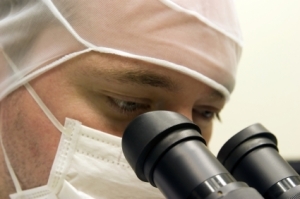Breakthrough in Electron Microscopy Could Allow Imaging of Living Cells
by
Brendon Nafziger, DOTmed News Associate Editor | October 14, 2009

A theoretical advance
in electron microscopy
MIT engineers may have overcome the final hurdle for electron microscopes.
As reported in this month's Physical Review A - Rapid Communications, researchers, led by Mehmet Fatih Yanik, Ph.D., a professor at MIT, have developed a concept for an electron microscope that could do what was previously thought impossible: imaging living cells.
Electron microscopes use electrons instead of light to create detailed images at the nanoscale, allowing researchers to view the inner workings of cells. But this improved resolution -- 10,000 times greater than light microscopy -- has a cost, at least for the cells. Because electrons are bursting with energy, they smash through the chemical links that keep cells alive.
"Electrons...have tens of thousands of times more energy than the atomic bonds that make up molecules," Dr. Yanik tells DOTmed News by email. "So, while they transmit through a sample, they transfer energy to and break molecular bonds in enzymes and DNA, causing massive damage, and eventual cell death."
"There is no cell type that can withstand such dramatic damage," he adds.
The electron "road not taken"
Dr. Yanik's solution is to create a new electron microscope that would allow electrons to "map" the image of an object without ever having to come into contact with it, thus potentially allowing scientists to keep a cell alive while viewing it.
The trick is to rely on an electron's quantum collapse.
As Yanik explains it, electrons, as weird quantum particles, can travel on two paths at the same time. If an electron comes against an object on one of these paths, it can no longer exist in both paths, but "collapses" into the one that doesn't contain the object, at least if the conditions resemble those in Yanik's paper.
For the theoretical microscope, there would be two ring-shaped paths. One of the paths would contain the object (the cell), while the other wouldn't have an obstacle. The electrons would circulate through the paths by using special electromagnetic traps. At the moment the electron comes upon the cell in one of the rings, it is immediately collapsed into the free path, so theoretically, the cell isn't harmed.
"If the electron doesn't transmit through the object, it forces the electron to switch to the path without the object, thus the electron avoids colliding with the object. By measuring changes in the electron's path, one can tell whether the object was opaque (non-transmitting) or transparent (transmitting) without any electron collision with the object. By scanning the object pixel-by-pixel, we could then construct an image of it," Dr. Yanik argues.
